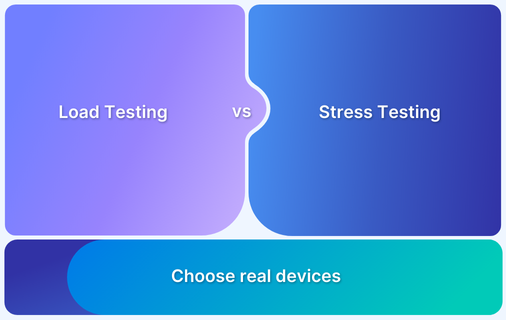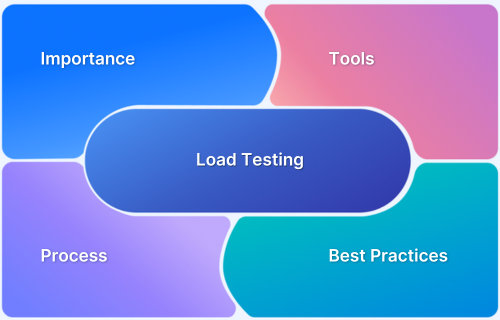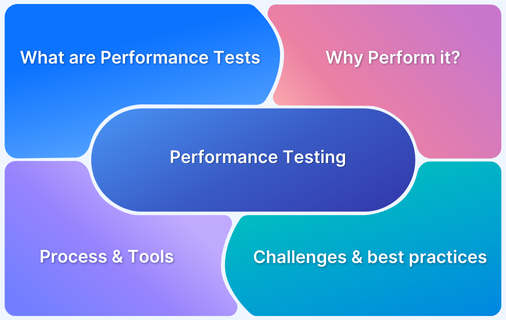Applications must perform reliably under pressure, whether from sudden traffic spikes or unexpected system issues. Stress testing helps teams uncover how software behaves when pushed beyond normal capacity, revealing weaknesses before they affect users.
Overview
What is Stress Testing?
Stress testing is a type of performance testing that evaluates how software behaves under extreme or unfavorable conditions. It reveals breaking points and recovery limits.
Why It’s Important
Stress testing ensures your application can handle unexpected spikes, system strain, or limited resources. It helps identify critical failures, improve resilience, and safeguard user experience.
Best Stress Testing Tools
- Apache JMeter: Open-source and widely used for HTTP and API load testing
- K6: Developer-friendly with scripting support for high-performance testing
- Gatling: Powerful for simulating large-scale user traffic with real-time reports
- Locust: Python-based and scalable for distributed load generation
- BlazeMeter: Cloud-based platform compatible with JMeter and other tools
- Artillery: Lightweight, scriptable tool ideal for testing APIs and microservices
- NeoLoad: Enterprise-grade solution for complex, large-scale performance and stress testing
This article provides a complete guide to stress testing, covering its purpose, types, key metrics, tools, benefits, and how it compares to load and performance testing.
What is Stress Testing?
Stress testing is a type of performance testing that evaluates how a system behaves under extreme or abnormal conditions. It measures system robustness by pushing it beyond expected load levels, such as high user traffic, intensive API requests, or large-scale data processing. The goal is to identify how the system handles failures, manages errors, and reaches its exhaustion point.
This testing also verifies whether auto-scaling mechanisms and failover strategies function correctly under stress. By identifying breaking points early, teams can proactively address weaknesses, reduce the risk of downtime, and improve overall system stability.
Purpose of Stress Testing
- Determine System Limits: Identify the maximum load the system can handle before it fails.
- Validate Stability: Ensure the application remains functional during sudden traffic spikes or resource exhaustion.
- Assess Recovery Mechanisms: Test how well the system recovers after a crash or failure.
- Identify Performance Bottlenecks: Uncover issues like slow database queries or memory leaks.
- Ensure Failover Readiness: Verify that backup systems and redundancy measures activate correctly during failures.
- Improve Scalability: Check if auto-scaling and load distribution mechanisms respond effectively under pressure.
Examples of Stress Testing
A bug tracking system is stress tested by simulating thousands of testers logging defects, updating issue statuses, and generating reports at the same time. This helps identify whether the application can handle high volumes of concurrent activity without slowing down, crashing, or losing data.
When to Perform Stress Testing
Stress testing is most effective when conducted at key stages of the software development and deployment lifecycle:
- Before Major Releases: Validate system stability under pressure before releasing to production.
- After Infrastructure Changes: Test how upgrades or configuration changes affect performance under load.
- Before Peak Usage Periods: Prepare for high-traffic events like product launches, sales campaigns, or seasonal spikes.
- During Scalability Planning: Assess how the system handles increased demand to guide scaling strategies.
- After Critical Bug Fixes: Ensure fixes do not introduce new performance issues under stress.
Performing stress testing at the right time helps teams catch issues early, reduce risk, and deliver a more reliable user experience.
Who Should Perform Stress Testing
Stress testing typically involves collaboration between multiple technical roles to ensure accurate setup, execution, and analysis:
- Performance Engineers: Lead the design and execution of stress tests. They define load scenarios, configure tools, and analyze system behavior under extreme conditions.
- DevOps and Infrastructure Teams: Monitor server performance, resource utilization, and infrastructure stability during the test. They help identify issues related to auto-scaling, failover, and capacity.
- QA/Test Engineers: Integrate stress testing into the broader testing strategy and validate that the system meets non-functional requirements.
- Developers: Review test results to identify code-level inefficiencies or resource-heavy operations that may cause bottlenecks.
- SREs (Site Reliability Engineers): Focus on system resilience and recovery. They use stress testing results to improve fault tolerance and system reliability under failure conditions.
In agile or DevOps environments, stress testing is often a shared responsibility across teams. Collaboration ensures that both application-level and infrastructure-level risks are addressed effectively.
Read More: Functional Testing : A Detailed Guide
Why Perform Stress Testing
Stress testing helps uncovers vulnerabilities in both the application and infrastructure that might not appear under normal conditions.
- Identify System Limits: Determine how many users, transactions, or processes the system can handle before performance degrades or failure occurs.
- Validate Error Handling: Ensure the system responds predictably under pressure, returning appropriate errors, timing out cleanly, or redirecting traffic when overloaded.
- Test Infrastructure Scalability: Verify whether components like auto-scaling groups, load balancers, and failover systems respond correctly to high traffic or resource usage.
- Uncover Performance Bottlenecks: Reveal slow queries, memory issues, thread contention, or input-output delays that become critical under stress.
- Prepare for Peak Demand: Simulate real-world traffic surges to ensure the system stays stable during expected spikes, such as major releases or promotions.
- Improve System Resilience: Use insights from failures to refine application logic, infrastructure configuration, and monitoring practices.
Types of Stress Testing
Stress testing can take different forms depending on what aspect of the system is being evaluated. Each type helps uncover specific weaknesses under high load or constrained conditions.
- Distributed Stress Testing: Simulates load from multiple machines or locations to test how the system performs under large-scale, geographically dispersed traffic.
- Application Stress Testing: Targets specific components such as APIs, databases, or services to identify performance bottlenecks, deadlocks, or memory leaks.
- Systemic Stress Testing: Applies load across multiple subsystems simultaneously (like database, server, and network) to observe how interconnected components respond together.
- Exploratory Stress Testing: Introduces unexpected conditions such as sudden spikes, dropped connections, or rapid configuration changes to evaluate system behavior during edge cases.
- Transactional Stress Testing: Focuses on high volumes of critical business transactions (like payments or logins) to assess how the system handles spikes in real-time operations.
- Failover Stress Testing: Simulates component failures under stress, such as crashing a service or disconnecting a database, to test how well failover and recovery mechanisms respond.
Key Metrics for Stress Testing
Metrics offer critical insights into how a system behaves under extreme conditions. Some key metrics of stress testing include:
Scalability and Performance Metrics
- Throughput: It is a basic metric that measures how well the system handles data size per second. It helps determine the system’s capacity to sustain increasing workloads over time.
- Pages: This metric tracks the number of pages users request from a system per second. It is important for understanding how the system performs when handling multiple concurrent page requests.
Application Response Metrics
- Hit Time: It is the average time it takes for the system to retrieve a page or an image. Lower hit times contribute to better system performance and a smoother user experience.
- Page Time: It measures how long it takes the system to retrieve all the data required for a page. It evaluates the efficiency of the page loading process.
- Time to First Byte: This metric tracks the time a system takes to return the first byte of information in response to a request. It provides insight into how quickly the system starts processing requests.
Failure Metrics
- Failed Hits: This metric refers to the number of times the system fails to provide requested information, such as missing images or broken links. This metric highlights failures in content delivery.
- Failed Rounds: These are the number of test scenarios where the system fails to execute properly. It helps identify test execution issues or functional breakdowns under stress.
- Failed Connections: The number of failed connections measures how many attempts to connect to the system are refused or result in a weak signal. High rates of failed connections indicate potential network or infrastructure problems.
How to Perform Stress Testing
Performing stress testing involves a series of steps to assess a system’s behavior under extreme conditions. Below are the key steps:
- Planning the Stress Test: Start by planning the test. Gather the necessary data and define your goals. Identify the system components you want to test and set the load parameters.
- Create Automation Scripts: Next, create automation scripts using tools like JMeter or LoadRunner. Set up the test data and include scenarios for normal and peak loads.
- Script Execution: Once the scripts are ready, execute them while gradually increasing the load or applying sudden spikes. Monitor system performance and behavior, including response time, error rates, and resource usage.
- Result Analysis: After running the tests, analyze the metrics such as response time, throughput, error rates, and failures. Identify bottlenecks and failure points, and assess how well the system recovers from stress.
- Optimization: Based on the analysis, optimize the system. Fine-tune resources, improve error handling and enhance recovery mechanisms. Re-test to ensure the improvements are effective.
Challenges and Limitations of Stress Testing
Stress testing is essential for assessing system robustness, but it comes with its challenges and limitations:
- Resource Intensive: Stress testing requires substantial resources. Running tests with high traffic loads or long durations can be costly, especially for large-scale systems or applications with complex infrastructures.
- False Positives/Negatives: Stress tests might yield false positives, where the system appears to fail due to non-ideal test conditions. Conversely, false negatives may occur when the system appears robust under stress but fails under real-world scenarios that weren’t accounted for during testing.
- Limited Test Coverage: Stress tests focus on specific components or behaviors under extreme conditions. However, they may miss underlying issues that could arise in everyday usage, like usability problems or performance degradation under normal load.
- Difficulty in Identifying Root Causes: Stress testing highlights where failures occur but does not always provide insights into the root causes. Performance issues might stem from multiple sources, such as database queries, network latency, or inefficient code.
- Scalability Issues in Test Environments: Sometimes, the test environment doesn’t replicate the production environment accurately. Limited resources or constraints in the testing setup may not allow full-scale testing, leading to incomplete results.
- Complexity in Managing Large Tests: Managing large-scale stress tests with numerous variables and scenarios can be complex. Coordinating multiple tools, teams, and test parameters can lead to confusion and inconsistent results.
- Simulating Real-World Conditions: Replicating real user conditions can be difficult. Traffic patterns, user behavior, and system load in real life are often unpredictable, making it hard to simulate exact scenarios in a test environment.
Best Stress Testing Tools
To effectively carry out stress testing, selecting the right tools is crucial. Here are some of the best options available to help you simulate high traffic and extreme conditions on your system:
- Apache JMeter: This open-source tool is widely used for load and stress testing web applications. Supporting a range of services such as databases and web servers, it is recognized for its ease of use and extensibility, making it a popular choice for stress testing.
- K6: Designed with developer-centric environments in mind, this modern, open-source performance testing tool supports scripting in JavaScript. It integrates well into CI/CD pipelines, making the testing process more streamlined and efficient.
- Gatling: Known for its high performance, this open-source tool is ideal for load and stress testing, particularly for high-traffic web applications. It uses Scala for test scripting, offering greater flexibility and control over testing scenarios.
- Locust: Built with Python, this tool enables the simulation of millions of concurrent users, making it highly scalable and customizable. It’s well-suited for load and stress testing in distributed environments, allowing for extensive testing in high-traffic situations.
- BlazeMeter: Based on Apache JMeter, this cloud-based platform makes it easy to scale and perform global load testing. It is especially effective for high-traffic applications and provides real-time results from multiple locations around the world.
- Artillery: A lightweight and modern tool that is perfect for testing APIs and microservices. With support for multiple protocols, Artillery is designed to be both simple and powerful, making it ideal for testing in cloud and microservice environments.
- NeoLoad: As an enterprise-grade performance testing solution, NeoLoad is tailored for web and mobile applications. It offers advanced analytics and integrates seamlessly with CI/CD pipelines, which makes it effective for large-scale applications and complex user scenarios.
While stress testing tools evaluate performance under extreme load, testing on real devices ensures consistent performance across different environments. BrowserStack’s cloud-based platform allows testing on 3,500+ real devices and browser combinations, ensuring seamless cross-browser and cross-device compatibility.
With features like real-time testing, automated screenshots, and CI/CD pipeline integration, BrowserStack helps you deliver a flawless user experience. Incorporating it into your workflow ensures your app performs optimally across all platforms before release.
Performance Testing vs Stress testing
The table below highlights the key differences between performance testing and stress testing, helping clarify when and why to use each approach
| Aspect | Performance Testing | Stress Testing |
|---|---|---|
| Purpose | Evaluates how a system performs under expected load conditions | Evaluates how a system performs under extreme or beyond-limit loads |
| Focus | Measures speed, stability, and scalability | Tests robustness, error handling, and recovery under stress |
| Common Metrics | Response time, throughput, resource usage | Failure rate, crash points, recovery time |
| End Goal | Validate performance benchmarks | Identify breaking points and ensure stability under failure |
| Use Case | Ongoing performance validation during development and updates | Used before major releases or infrastructure changes |
Read More: Top 20 Performance Testing Tools
Load testing vs. Stress testing
Here is a comparison table for Load Testing vs. Stress Testing:
| Aspect | Load Testing | Stress Testing |
|---|---|---|
| Purpose | To determine how the system performs under expected user loads | To evaluate system stability beyond its maximum capacity |
| Focus | Performance under normal to peak load conditions | Behavior under extreme or breaking point conditions |
| Common Metrics | Response time, throughput, resource utilization | Error rate, system crashes, recovery time, bottlenecks |
| End Goal | Ensure the application handles anticipated traffic efficiently | Identify the system’s failure point and evaluate its recovery mechanisms |
| Use Case | Used before major releases or feature rollouts to validate performance | Used to test recovery plans and stability under unexpected surges |
For a detailed comparison of these two testing approaches, refer to: Load Testing vs. Stress Testing: The Main Differences.
Conclusion
Stress testing is crucial to ensure that your software can handle extreme and unexpected stress conditions. It helps uncover system limitations, detect performance issues, and validate recovery strategies before they affect real users.
Incorporating stress testing into your development process improves the reliability and resilience of your application, ensuring a smoother experience even during high-demand situations.
To complement stress testing, platforms like BrowserStack help teams verify consistent performance and user experience across real devices and browsers.






